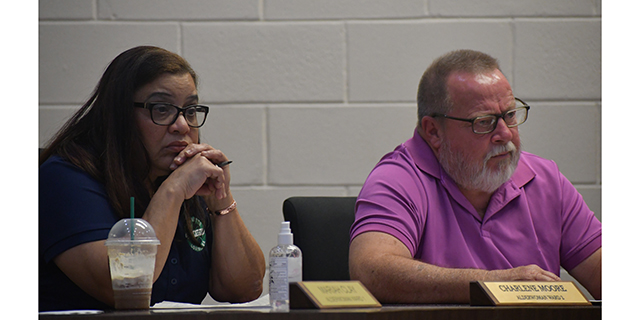State adds 974 new cases from 19,159 new tests
Published 7:00 am Wednesday, March 17, 2021

- Louisiana has widened its eligiblity requirements for the COVID vaccine and limited doses are available at many locations.
The LDH update Tuesday showed 974 new COVID-19 cases based on 19,159 new tests, pushing the state’s total of identified cases to 438,557.
Of the overall identified cases, 375,872 are confirmed, with 62,685 listed as possible cases.
Trending
According to an LDH spokesman, people initially identified as having a positive antigen test who are later identified as having a positive confirmatory test will be removed from the possible case count and added to the cumulative case count.
The rough positivity rate for the new cases reported Tuesday was 5.1 percent.
Louisiana had 9,925 total COVID-19 deaths as of Tuesday, with 22 new deaths added. Of the total deaths, 9,162 are confirmed with 763 considered probable COVID-19 fatalities pending final testing.
The average age of fatal patients remained at 75, while the median age was at 76 as of Feb. 24.
Local numbers
In Iberia Parish, the number of cases rose to 6,584 Tuesday, an increase of nine. Of those, 6,041 are confirmed, with 543 probable. The number of deaths remained at 148, with 136 confirmed and 12 probable. There have been 85,763 tests performed in the parish. The seven-day average test positivity dropped 17 percent, from 4.7 percent on Feb. 24 to 3.9 percent on March 3. The incidence of tests dropped by 44.6 percent, from 117 per 10,000 population on Feb. 24 to 64.8 on March 3.
Trending
St. Martin Parish’s number of identified cases rose to 4,928, an increase of 33, with 60,173 tests performed. The seven-day average test positivity rate dropped from 4.5 percent on Feb. 24 to 3.5 percent on March 3, a 22.2 percent decrease, while the testing incidence rate per 10,000 population dropped 15.8 percent, from 70.87 on Feb. 24 to 59.68 on March 3. The number of deaths rose by one, to 115, with 103 confirmed and 12 probable.
In St. Mary Parish, the seven-day positivity rate rose to 6.2 percent as of March 3, up from 4.3 percent on Feb. 24, a 44.2 percent increase. The testing incidence rate per 10,000 population dropped, from 140.6 on Feb. 24 to 132.6 on March 3. Total cases Tuesday rose to 4,290, after 52,638 tests. Of those positive tests, 3,410 are confirmed, with 880 probable. The number of COVID-19 deaths rose by one, to 126, with 112 confirmed and 14 probable.
Around the state
In Lafayette Parish, the Tuesday case count rose by 49, to 21,972, with the number of tests rising to 298,443. The seven-day test positivity average rose from 3 percent on Feb. 24 to 3.6 percent as of March 3, an increase of 20 percent. The testing incidence rate per 10,000 population rose during the same period, from 62.2 to 65.5, a 5.3 percent increase. The number of deaths remained at 266, with 248 confirmed and 18 probable.
The number of cases in Jefferson Parish rose to 44,608 on Tuesday, compared to an increase to 28,970 in Orleans Parish. The latest data shows Orleans administered more tests, with 815,440, compared to 585,818 tests in Jefferson.
Jefferson Parish continues to surpass the COVID-19 death toll in Orleans Parish. Orleans Parish deaths were at 775, with 726 confirmed and 49 probable. In Jefferson Parish, the total number of deaths rose to 868, with 833 confirmed and 35 probable.
Hospitalizations
The LDH reporting showed hospitalizations statewide due to coronavirus infections dropped by two, to 453 on Monday. The number of patients on ventilators dropped by four, to 62.
The number of COVID-19 hospitalizations in Region 4, which covers Acadiana, rose by three, to 51 Monday. The number of patients on ventilators remained at six.
Overall hospital bed occupancy in Region 4 Monday was below 70 percent, at 69.3 percent, with 1,152 of the region’s beds occupied and 510 available. The total number of reported beds was at 1,662.
Overall intensive care unit occupancy across Acadiana was at 77.3 percent Monday, with 119 of 154 beds occupied.
The overall occupancy percentages are based on all cases, not just COVID-19 cases, and includes not only the physical bed and space but also the staff required to issue care. The burden of additional patient load affects the ability of hospitals to serve all patients, especially in critical care situations.
By age group
Broken down by age group, the number of cases statewide in the 18 to 29 demographic was at 89,345 Tuesday. It is the demographic group with the largest number of identified cases by far. The number of deaths reported in the group was 35.
The number of COVID-19 cases identified in the 30 to 39 age group was at 70,367, with 127 deaths, followed closely by the 40 to 49 age group, with 63,803 cases and 288 deaths, and the 50 to 59 age range with 63,170 cases, including 826 fatalities reported.
In the 60 to 69 age group, there were 50,606 cases reported and 1,871 deaths. This age group has the second-highest number of deaths, behind only the 70 and above demographic group.
The 70 and above group case count was at 45,235. The number of deaths in that group rose to 6,771 — still the largest number of fatalities for any age group by far, more than the number of deaths in all other groups combined and more than two-thirds of the total COVID-19 attributed deaths in the state.
The under 18 group had 55,716 cases total — 10,167 age 4 and under — and seven reported deaths.
Seven-day average
The state’s seven-day average of tests given as of March 3 was 223.3 tests per 10,000 residents, down from 249.3 on Feb. 24. The positivity rate among those tests dropped by four-tenths of a point as of March 3 to 3.2 percent, down from 3.6 percent on Feb. 24.
In Region 4, the March 3 testing rate was even lower, at 194.4 tests per 10,000 residents. The seven-day average percent positive of those tests was higher than the state average at 3.9 percent, up from 3.5 percent on Feb. 24.
According to Tuesday’s update, labs in Louisiana have processed 6,266,600 COVID-19 tests so far.
Gender, underlying conditions
By gender, the state’s bi-weekly report shows women still making up the largest part — 56 percent — of the identified COVID-19 cases in the state, with men comprising 44 percent. On the other hand, the COVID-19 deaths are predominantly among men, 53.2 percent to 46.8 percent for women.
The number of presumed recovered cases, as of March 8, rose to 420,459. In order to be considered recovered, a living patient must either be out of the hospital and 14 days past a positive test result, or 21 days past a positive test date if their hospitalization status is unknown.
Initially, LDH reported that 70 percent of all COVID-19 deaths in the state were in the Black community. That number dropped to 38.4 percent as of March 10, while White victims now make up 60.1 percent of all fatal cases.
The Native American/Alaskan Native total was at 0.15 percent. Native Hawaiian/Pacific Islander data remained at 0.08 percent. Other races identified include Asian at 0.81 percent, Unknown at 0.01 percent and Other at 0.4 percent.
That data is supposed to be reported once every two weeks as of the beginning of the year.
The top three underlying conditions among COVID-19 deaths in the March 3 report were hypertension (62.7 percent), diabetes (36.9 percent), and cardiac disease (27 percent).
Other factors included neurological disorders (26.3 percent), chronic kidney disease (21.4 percent), obesity (21.1 percent), congestive heart failure (16.3 percent), pulmonary issues (14.7 percent), cancer (8.8 percent), and asthma (4.1 percent). Only 4.2 percent of all patients had no underlying conditions.
Dwayne Fatherree is the community editor for The Daily Iberian. He can be reached at dwayne.fatherree@daily-iberian.com.
This week, 628 vaccine providers across the state will receive very limited doses of COVID vaccine. These providers include national and independent pharmacies, public health providers, clinics and physician offices, hospitals and others. The full breakdown is as follows:
• 260 chain pharmacies (including 116 Walmarts, 7 Sam’s Clubs, and 75 CVS from retail pharmacy program)
• 164 independent pharmacies
• 66 hospitals
• 46 public health providers
• 26 urgent cares
• 31 federally qualified health centers (FQHCS)
• 15 medical practices
• 8 rural health clinics (RHCs)
• 12 other healthcare providers
LDH has published the list of participating providers, along with their locations and contact information online at covidvaccine.la.gov. In addition to these providers, community vaccination events are taking place across the state and are also listed on LDH’s website. Residents can call 211 to find a vaccine provider or event near them.





